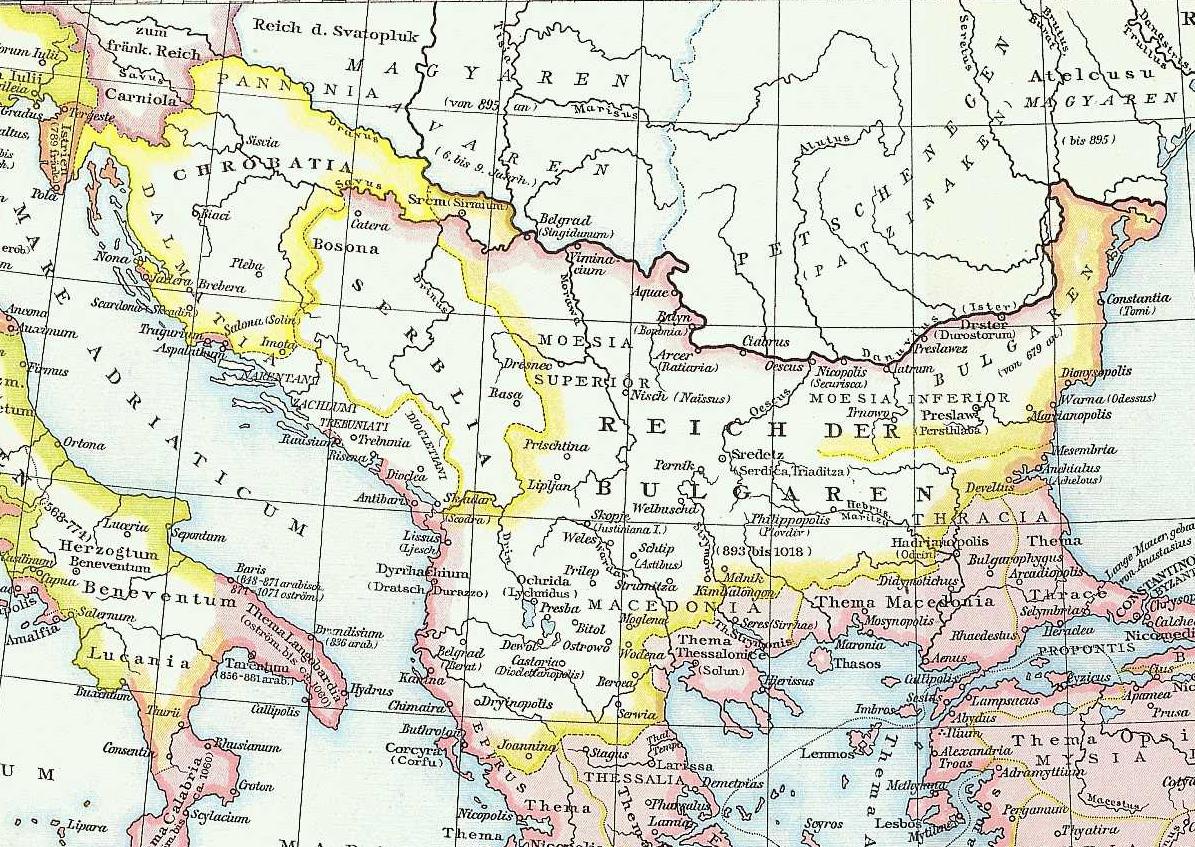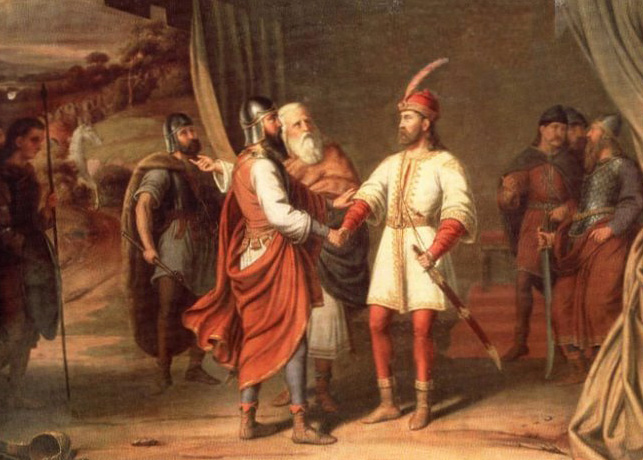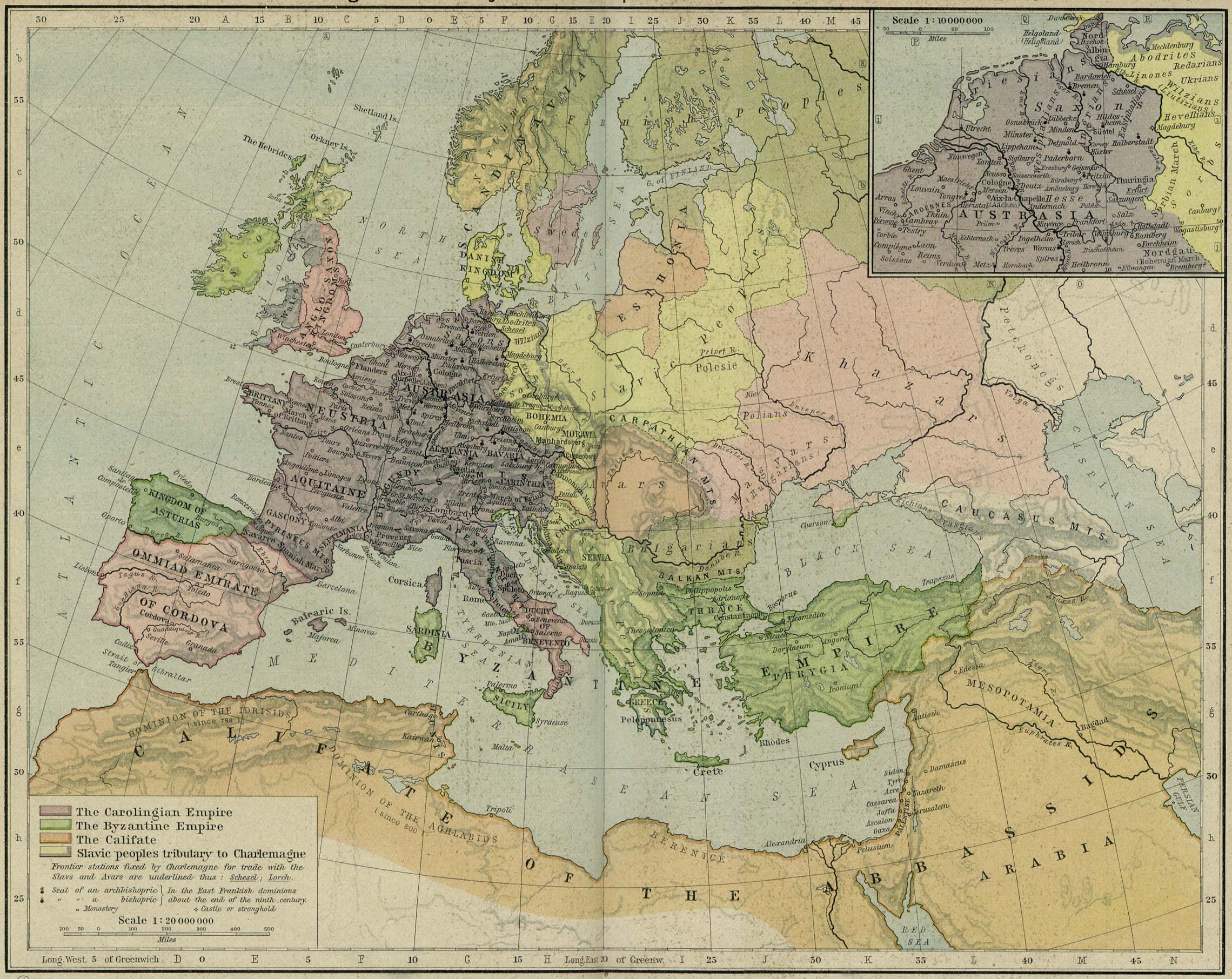|
Vladislav Of Croatia
Vladislav or Ladislas ( la, Ladasclavus; 821) was the Duke of Croatia. In sources he is mentioned as the Duke of Dalmatia and Liburnia (''dux Dalmatiae atque Liburnae''), having succeeded his uncle Borna, a Frankish vassal. He is mentioned only in the 9th-century ''Royal Frankish Annals'', regarding year 821. Borna had died between January and October 821, during a war against Frankish rebel Ljudevit, Duke of Pannonian Croatia. Borna's nephew (by his sister) Vladislav succeeded him, by the people's will and emperor's approval. Vladislav ruled from Nin as a loyal vassal of the Frankish Emperor Lothair I Lothair I or Lothar I ( Dutch and Medieval Latin: ''Lotharius''; German: ''Lothar''; French: ''Lothaire''; Italian: ''Lotario'') (795 – 29 September 855) was emperor (817–855, co-ruling with his father until 840), and the governor of Bava .... In historiography, his realm has been referred to as Dalmatian Croatia or Littoral Croatia, where he was succeeded by Duke Mi ... [...More Info...] [...Related Items...] OR: [Wikipedia] [Google] [Baidu] |
Duke Of Croatia
This is a complete list of rulers of Croatia under domestic ethnic and elected dynasties during the Croatian Kingdom (925–1918). This article follows the monarch's title number according to Hungarian succession for convenience. For example, the Hungarian monarch Béla IV is according to Croatian succession correctly titled Béla III. This is because Hungarians had a king named Béla prior to the incorporation of Croatia under the Hungarian Crown but the Croats did not. Early history The details of the arrival of the Croats in the Balkans are sparsely documented by reliable historical sources. Around 626 CE, Croats migrated from White Croatia (around present-day Galicia) at the invitation of the Byzantine Emperor Heraclius. According to a legend recorded in the 10th-century ''De Administrando Imperio'', the Croats came to their present region under the leadership of five brothers (called Kloukas, Lobelos, Kosentzis, Mouchlo, and Chrobatos) and of two sisters (called Touga an ... [...More Info...] [...Related Items...] OR: [Wikipedia] [Google] [Baidu] |
Dalmatian Croatia
The Duchy of Croatia (; also Duchy of the Croats, hr , Kneževina Hrvata; ) was a medieval state that was established by White Croats who migrated into the area of the former Roman province of Dalmatia 7th century CE. Throughout its existence the Duchy had several seats – namely, Klis, Solin, Knin, Bijaći and Nin. It comprised the '' littoral –'' the coastal part of today's Croatia ''–'' except Istria, and included a large part of the mountainous hinterland as well. The Duchy was in the center of competition between the Carolingian Empire and the Byzantine Empire for rule over the area. Croatian rivalry with Venice emerged in the first decades of the 9th century and would continue through the following centuries. Croatia also waged battles with the Bulgarian Empire (founded ; Bulgar-Croatian relations improved greatly afterwards) and with the Arabs; it also sought to extend its control over important coastal cities under the rule of Byzantium. Croatia experienc ... [...More Info...] [...Related Items...] OR: [Wikipedia] [Google] [Baidu] |
9th-century Slavs
The 9th century was a period from 801 ( DCCCI) through 900 ( CM) in accordance with the Julian calendar. The Carolingian Renaissance and the Viking raids occurred within this period. In the Middle East, the House of Wisdom was founded in Abbasid Baghdad, attracting many scholars to the city. The field of algebra was founded by the Muslim polymath al-Khwarizmi. The most famous Islamic Scholar Ahmad ibn Hanbal was tortured and imprisoned by Abbasid official Ahmad ibn Abi Du'ad during the reign of Abbasid caliph al-Mu'tasim and caliph al-Wathiq. In Southeast Asia, the height of the Mataram Kingdom happened in this century, while Burma would see the establishment of the major kingdom of Pagan. Tang China started the century with the effective rule under Emperor Xianzong and ended the century with the Huang Chao rebellions. While the Maya experienced widespread political collapse in the central Maya region, resulting in internecine warfare, the abandonment of cities, an ... [...More Info...] [...Related Items...] OR: [Wikipedia] [Google] [Baidu] |
Nobility Of The Carolingian Empire
Nobility is a social class found in many societies that have an aristocracy. It is normally ranked immediately below royalty. Nobility has often been an estate of the realm with many exclusive functions and characteristics. The characteristics associated with nobility may constitute substantial advantages over or relative to non-nobles or simply formal functions (e.g., precedence), and vary by country and by era. Membership in the nobility, including rights and responsibilities, is typically hereditary and patrilineal. Membership in the nobility has historically been granted by a monarch or government, and acquisition of sufficient power, wealth, ownerships, or royal favour has occasionally enabled commoners to ascend into the nobility. There are often a variety of ranks within the noble class. Legal recognition of nobility has been much more common in monarchies, but nobility also existed in such regimes as the Dutch Republic (1581–1795), the Republic of Genoa (1005–1 ... [...More Info...] [...Related Items...] OR: [Wikipedia] [Google] [Baidu] |
9th-century Croatian People
The 9th century was a period from 801 ( DCCCI) through 900 ( CM) in accordance with the Julian calendar. The Carolingian Renaissance and the Viking raids occurred within this period. In the Middle East, the House of Wisdom was founded in Abbasid Baghdad, attracting many scholars to the city. The field of algebra was founded by the Muslim polymath al-Khwarizmi. The most famous Islamic Scholar Ahmad ibn Hanbal was tortured and imprisoned by Abbasid official Ahmad ibn Abi Du'ad during the reign of Abbasid caliph al-Mu'tasim and caliph al-Wathiq. In Southeast Asia, the height of the Mataram Kingdom happened in this century, while Burma would see the establishment of the major kingdom of Pagan. Tang China started the century with the effective rule under Emperor Xianzong and ended the century with the Huang Chao rebellions. While the Maya experienced widespread political collapse in the central Maya region, resulting in internecine warfare, the abandonment of cities, and a north ... [...More Info...] [...Related Items...] OR: [Wikipedia] [Google] [Baidu] |
Year Of Birth Unknown
A year or annus is the orbital period of a planetary body, for example, the Earth, moving in its orbit around the Sun. Due to the Earth's axial tilt, the course of a year sees the passing of the seasons, marked by change in weather, the hours of daylight, and, consequently, vegetation and soil fertility. In temperate and subpolar climate, subpolar regions around the planet, four seasons are generally recognized: spring (season), spring, summer, autumn and winter. In tropics, tropical and subtropics, subtropical regions, several geographical sectors do not present defined seasons; but in the tropics#Seasons and climate, seasonal tropics, the annual wet season, wet and dry seasons are recognized and tracked. A calendar year is an approximation of the number of days of the Earth's orbital period, as counted in a given calendar. The Gregorian calendar, or modern calendar, presents its calendar year to be either a common year of 365 days or a leap year of 366 days, as do t ... [...More Info...] [...Related Items...] OR: [Wikipedia] [Google] [Baidu] |
Dukes Of Croatia
This is a complete list of rulers of Croatia under domestic ethnic and elected dynasties during the Croatian Kingdom (925–1918). This article follows the monarch's title number according to Hungarian succession for convenience. For example, the Hungarian monarch Béla IV is according to Croatian succession correctly titled Béla III. This is because Hungarians had a king named Béla prior to the incorporation of Croatia under the Hungarian Crown but the Croats did not. Early history The details of the arrival of the Croats in the Balkans are sparsely documented by reliable historical sources. Around 626 CE, Croats migrated from White Croatia (around present-day Galicia) at the invitation of the Byzantine Emperor Heraclius. According to a legend recorded in the 10th-century '' De Administrando Imperio'', the Croats came to their present region under the leadership of five brothers (called Kloukas, Lobelos, Kosentzis, Mouchlo, and Chrobatos) and of two sisters (called Touga a ... [...More Info...] [...Related Items...] OR: [Wikipedia] [Google] [Baidu] |
835 Deaths
__NOTOC__ Year 835 ( DCCCXXXV) was a common year starting on Friday (link will display the full calendar) of the Julian Calendar. Events By place Europe * Ragnar Lodbrok, a Norse Viking ruler, rises to power. He becomes the scourge of France and England (approximate date). * Viking raids in Ireland on the Kingdom of Munster at Inish Cathaigh Britain * Danish Viking raiders ally with the Cornish, against the rule of King Egbert of Wessex (approximate date). * The Isle of Sheppey (off the northern coast of Kent) is attacked by Vikings. China * December 14 – Sweet Dew Incident: Emperor Wen Zong plots to free the court from the influence of his palace eunuchs. In the northeast sector of the capital Chang'an, after the failure of the emperor's chancellor Li Zhongyan to subdue the eunuchs' influence, troops under the eunuchs' command slaughter many officials and other associates. By topic Religion * November 1 – Pope Gregory IV promotes the celebr ... [...More Info...] [...Related Items...] OR: [Wikipedia] [Google] [Baidu] |
Balkans In 9th Century
The Balkans ( ), also known as the Balkan Peninsula, is a geographical area in southeastern Europe with various geographical and historical definitions. The region takes its name from the Balkan Mountains that stretch throughout the whole of Bulgaria. The Balkan Peninsula is bordered by the Adriatic Sea in the northwest, the Ionian Sea in the southwest, the Aegean Sea in the south, the Turkish Straits in the east, and the Black Sea in the northeast. The northern border of the peninsula is variously defined. The highest point of the Balkans is Mount Musala, , in the Rila mountain range, Bulgaria. The concept of the Balkan Peninsula was created by the German geographer August Zeune in 1808, who mistakenly considered the Balkan Mountains the dominant mountain system of Southeast Europe spanning from the Adriatic Sea to the Black Sea. The term ''Balkan Peninsula'' was a synonym for Rumelia in the 19th century, the European provinces of the Ottoman Empire. It had a geopolitica ... [...More Info...] [...Related Items...] OR: [Wikipedia] [Google] [Baidu] |
Lothair I
Lothair I or Lothar I ( Dutch and Medieval Latin: ''Lotharius''; German: ''Lothar''; French: ''Lothaire''; Italian: ''Lotario'') (795 – 29 September 855) was emperor (817–855, co-ruling with his father until 840), and the governor of Bavaria (815–817), King of Italy (818–855) and Middle Francia (840–855). Lothair was the eldest son of the Carolingian emperor Louis the Pious and his wife Ermengarde of Hesbaye, daughter of Ingerman the duke of Hesbaye. On several occasions, Lothair led his full-brothers Pepin I of Aquitaine and Louis the German in revolt against their father to protest against attempts to make their half-brother Charles the Bald a co-heir to the Frankish domains. Upon the father's death, Charles and Louis joined forces against Lothair in a three-year civil war (840–843). The struggles between the brothers led directly to the breakup of the Frankish Empire assembled by their grandfather Charlemagne, and laid the foundation for the development of ... [...More Info...] [...Related Items...] OR: [Wikipedia] [Google] [Baidu] |
Borna (duke)
Borna was the Duke of Croatia from to 821 and vassal of the Frankish Empire. He resided in Nin and was the ruler of most of the Croats in northern Dalmatia.John Van Antwerp Fine: The Early Medieval Balkans: A Critical Survey from the Sixth to the Late Twelfth Century, 1991, p. 255 Borna's predecessor was Višeslav of Croatia, probably his father. After his death in 821, he was succeeded by his nephew Vladislav. He is mentioned in the Royal Frankish Annals (''Annales regni Francorum'') in entries regarding 818–821. His titles were "Duke of the Guduscani" (a Croatian tribe from Lika and northern Dalmatia) in 818; "Duke of Dalmatia" in 819; "Duke of Dalmatia and Liburnia" in 821. Historiography treats him as a ruler of '' Dalmatian Croatia''. History Borna is documented in the "Royal Frankish Annals" (''Annales regni Francorum''). He is first mentioned regarding an 818 meeting at Herstal of Frankish Emperor Louis the Pious with envoys of the Obotrites, Borna (duke of the G ... [...More Info...] [...Related Items...] OR: [Wikipedia] [Google] [Baidu] |
Franks
The Franks ( la, Franci or ) were a group of Germanic peoples whose name was first mentioned in 3rd-century Roman sources, and associated with tribes between the Lower Rhine and the Ems River, on the edge of the Roman Empire.H. Schutz: Tools, Weapons and Ornaments: Germanic Material Culture in Pre-Carolingian Central Europe, 400-750. BRILL, 2001, p.42. Later the term was associated with Romanized Germanic dynasties within the collapsing Western Roman Empire, who eventually commanded the whole region between the rivers Loire and Rhine. They imposed power over many other post-Roman kingdoms and Germanic peoples. Beginning with Charlemagne in 800, Frankish rulers were given recognition by the Catholic Church as successors to the old rulers of the Western Roman Empire. Although the Frankish name does not appear until the 3rd century, at least some of the original Frankish tribes had long been known to the Romans under their own names, both as allies providing soldiers, and as e ... [...More Info...] [...Related Items...] OR: [Wikipedia] [Google] [Baidu] |


.png)





